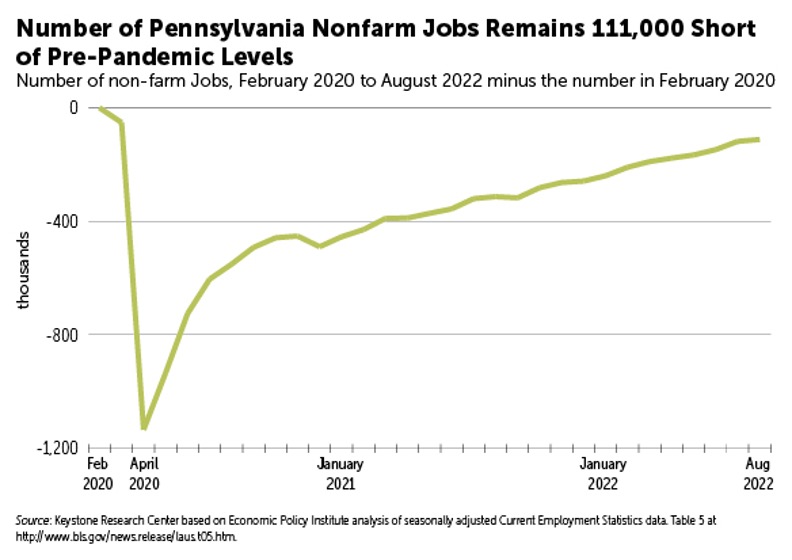The State of the Pennsylvania Economy
Keystone Research Center released the complete “State of Working Pennsylvania 2022” on August 30. The report shows that the economy is performing well from the perspective of regular workers, with wages rising across the board, unemployment low, and many more job openings than unemployed workers, giving workers bargaining power with employers.
The full “State of Working Pennsylvania” is long and dense, with too much information to cover in one media story and to digest in a single setting. Therefore, in blog entries over the next two months, we will rerelease the report in updated and sometimes abbreviated topical bites. To access the full report and other SWPA resources (press release, video of press webinar, PowerPoint presentation, op-eds, and media coverage), please visit our SWPA 2022 resource page.
This first blog updates our overview of the overall Pennsylvania economy, adding state numbers for August released on Friday of last week. One year ago, in “The State of Working Pennsylvania 2021,” we outlined the strides that Pennsylvania, the United States, and the world had taken to combat the dramatic initial effects of the COVID-19 pandemic and the deep, two-month recession that followed the first effort to tamp down the virus. Now, two and a half years since the start of the COVID-19 pandemic, the Pennsylvania and U.S. economies have fully recovered based on two key indicators—GDP and the unemployment rate.
The first figure shows the Pennsylvania gross domestic product (GDP) for the 10 most recent quarters of available data. The figure expresses GDP as a percent of the last full quarter before the pandemic, the fourth quarter of 2019, making it easier to see recent GDP trends and that the Pennsylvania GDP has tracked national GDP. Pennsylvania’s GDP dipped 11 percentage points between the first and second quarter of 2020 and then recovered to the fourth quarter of 2019 levels by the fourth quarter of 2021. With a drop in Pennsylvania GDP in the first quarter of 2022, GDP remained just above the pre-pandemic level.
Advance (i.e., “preliminary”) U.S. GDP estimates for the second quarter of 2022 suggest the U.S. may have had a second quarter of negative growth, leaving experts debating whether we have entered, or soon will enter, another recession. (The official non-preliminary estimate of second-quarter GDP will be announced on September 28, 2022.)
Continued, steady job growth—the U.S. added 315,000 jobs in August 2022 and 5.8 million over the past 12 months—and low unemployment (3.7%, nationally) indicate that we’re not in a recession.[1]
With August 2022 state numbers now available, Pennsylvania remains 111,000 non-farm jobs short of the pre-pandemic total but has added 98,000 non-farm jobs in the past six months and 202,000 in the last year.
Unemployment trends also show continued economic recovery. As the figure below shows, Pennsylvania’s unemployment is now substantially below its pre-pandemic rate. In August 2022, Pennsylvania’s unemployment rate was 4.2%, 0.8 percentage points lower than in February 2020. Pennsylvania’s August 2022 unemployment rate of 4.2% is a 22-year low, last equaled in June 2000. While the Pennsylvania unemployment rate remains 0.5 percentage points higher than the U.S. rate, the gap has narrowed from an average of 1.2 percentage points over the past 12 months.
While the overall unemployment rate is lower, the unemployment rates for Pennsylvania’s Black and Hispanic workers remain more than double the unemployment rate for white Pennsylvanians. (See the next figure.) The pandemic widened racial gaps in unemployment rates. In the fourth quarter of 2019, Black and Hispanic unemployment rates were 5 and 2.6 percentage points higher than white unemployment, respectively. By the fourth quarter of 2021, Black and Hispanic unemployment rates were 6.2 and 5.8 percentage points higher than white unemployment. The widening of racial unemployment gaps followed a pattern seen in prior recessions but was also exacerbated early in the pandemic because higher shares of Black and Hispanic workers worked in service industries, which faced the most precipitous employment declines in the effort to stem the spread of COVID-19.
Our next blog in this series will examine the state of Pennsylvania’s labor market, asking, “How great the resignation?” We will explore how many people have not returned to the Pennsylvania labor force who had jobs before the pandemic or were looking for them (i.e., were unemployed). We will also unpack some of the reasons why workers of different age groups have not fully returned to the labor force.
[1] Economic Policy Institute, “Jobs report doesn’t show signs of recession—yet—as the labor market remains strong:
The Fed should still be wary of raising interest rates much further,” August 4, 2022, https://www.epi.org/blog/jobs-report-doesnt-show-signs-of-recession-yet-as-labor-market-remains-strong-the-fed-should-still-be-wary-of-raising-interest-rates-much-further/.


